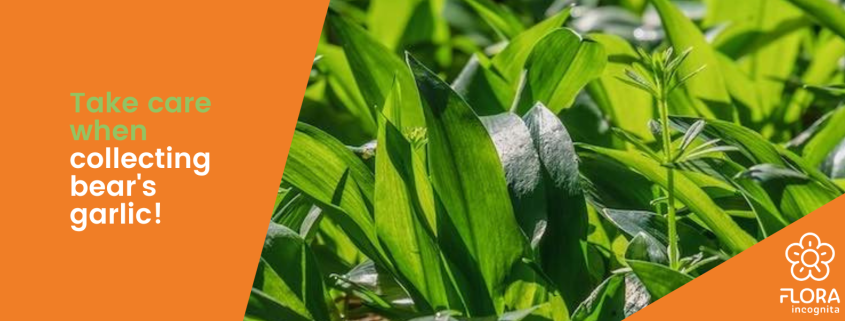How to not confuse Bear’s garlic with Lily-of-the-valley, autumn crocus, Jack-in-the-pulpit or Solomon’s seal!
Be careful when collecting wild garlic!
March to May is bear’s garlic season once again! Many people are now on the lookout for the young leaves for herb butter, pesto or soup, but beware! There are some poisonous plants that occur at similar times in the same locations: Lily of the Valley, Autumn Crocus, Jack-in-the-pulpit and Solomon’s Seal. A safe identification is therefore essential. Please only collect plants for consumption that you have been able to identify without doubt! You can identify the leaves with Flora Incognita, but you should also know how to distinguish bear’s garlic from the other confusing species.
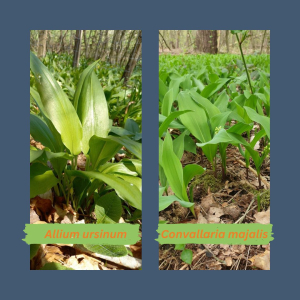
Bear’s garlic or lily of the valley?
You can find bear’s garlic leaves (Allium ursinum) from March to June in alluvial, deciduous and mixed forests. It is not uncommon to find the poisonous leaves of the lily of the valley (Convallaria majalis) mixed in! What is easiest is to look at how the leaves grow out of the ground: bear’s garlic seems to grow “straight out of the ground” and has a clearly recognisable stem, whereas lily of the valley usually sprouts two leaves from a rhizome – and they encompass a pseudo-stem. This means they are not as clearly divided into “stem and leaf” as bear’s garlic. Other distinguishing features are: Bear’s garlic leaves are dark green and soft, especially after picking they quickly start to collapse. Lily of the valley leaves are light green and firmer. Wild garlic has a clear midrib and parallel veins that are widely spaced. Lily of the valley does not have a distinct midrib and has very narrowly spaced nerves.
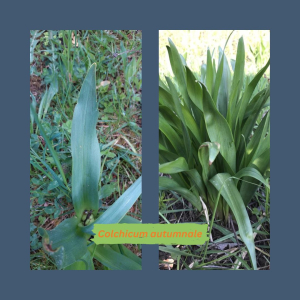
Bear’s garlic or autumn crocus?
Autumn crocus (Colchicum autumnale) sprout their leaves now – but they do not flower until autumn. Caution: Even eating the smallest amounts can lead to severe poisoning! You are more likely to find them in meadows than in the forest, and also their leaves are not clearly divided into “leaf and stem”. They grow without a stem from a rosette in the ground and also often enclose a large, green fruit capsule. Unlike bear’s garlic leaves, they are almost stiff and shiny on both sides – the underside of bear’s garlic leaves is rather dull.
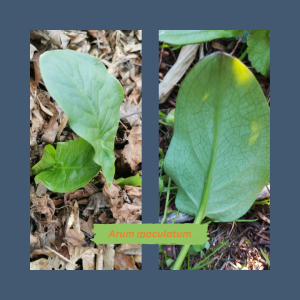
Bear’s garlic or Jack-in-the-pulpit?
It is mainly the young leaves of Jack-in-the-pulpit (Arum maculatum) that can lead to confusion with bear’s garlic – because they too are now sprouting in nutrient-rich deciduous forests. Very young leaves lack the typical spots and barbs at the base of the stem, but they already show the irregular veining, which clearly distinguishes them from bear’s garlic.
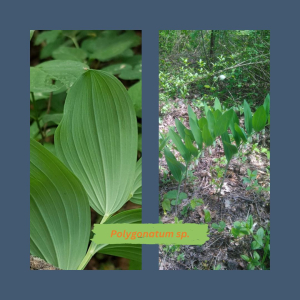
Bear’s garlic or Solomon’s seal?
Individual plants of bear’s garlic and the species of solomon’s seal (Polygonatum sp.) are probably unlikely to be confused. The risk here is rather that an individual specimen of solomon’s seal can become indistinguishable in mass occurrences of bear’s garlic and thus, in case of carelessness, be collected along with it. The parallel-veined, long-oval leaves are indeed similar to those of bear’s garlic, but they grow alternately on a stem and have a grey-green underside.
Olfactory test
Bear’s garlic is mainly recognisable by its aromatic smell, reminiscent of garlic. The confusing species don’t exactly do this, but if you have already collected and crushed a few leaves of bear’s garlic, your fingers will smell very strongly, making reliable identification by smell no longer possible.
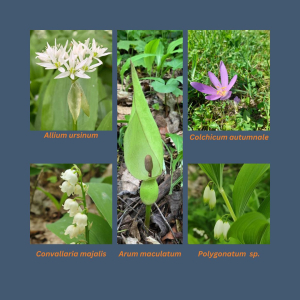
Observe plants in the course of the year
It is only the leaves that can lead to confusion with bear’s garlic. As with other plants that are collected for consumption, we recommend that you visit their locations regularly throughout the year and look at how the individual plants flower and fruit. This way you can be sure to see, feel and smell which leaves belong to which flower: Jack-in-the-pulpit forms a characteristic “stick” of spatha and cob between April and May. Lily of the valley forms grape-like bells, almost at the same time as bear’s garlic, which forms star-shaped pure white flowers from May to June. And lastly, the autumn crocus shows its pink flowers – in autumn.
This article was displayed as a story in the Flora Incognita app in spring 2022/23. In the app you can always find exciting information about plants, ecology, species knowledge, as well as tips and tricks for plant identification. Check it out!

